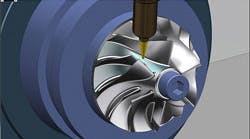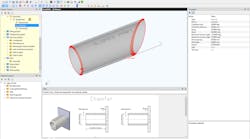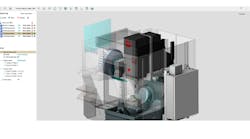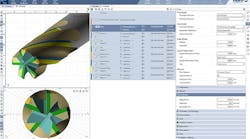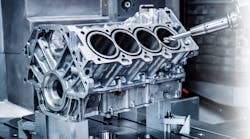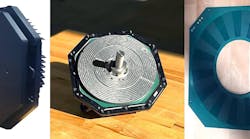NX Turbomachinery Milling offers a set of automated, context-specific functions that simplifies the generation of smart tool paths for these types of parts.
NX CMM Inspection Programming is complete with simulation and collision avoidance to help you validate CMM programming decisions.
Offline CMM programming can be automated by working in the context of a 3D solid model environment that includes the machine and the part.
The recent enhancements to Siemens PLM’s NX™ software, NX 7 — its integrated computer-aided design, manufacturing and engineering analysis (CAD/CAM/CAE) program — include significant new functionality but also supports Siemens PLM software’s new High Definition PLM (HD-PLM) technology framework.
"Our new HD-PLM technology framework, delivers a visually intuitive environment in NX to enhance the decision-making process throughout product development and create significant value for our customers and our industry," explains Siemens PLM’s v.p. of Product Design Solutions Joan Hirsch. "The value of this release is further magnified not only by the strength of its many enhancements, but also for the balanced level of new functionality added throughout the software’s various product design, analysis and part manufacturing modules, which can produce end user productivity gains of as much as 80 percent."The high-definition 3D (HD3D) environment delivers a product development decision support and analytics solution that personalizes the user’s experience by placing them in the proper context, assists proactively with task accomplishment to help make collaborative decisions, clarifies the user’s experience by presenting information intuitively and validates user decisions against established rationale. An efficient alternative to navigating and processing lists of attribute data and manually correlating them to 3D product models, HD3D enables users to comprehend PLM data visually, with interactive navigation, and to drill down to details as needed.
HD3D works with NX validation checking tools, providing direct visual interaction that accelerates the validation of product designs against requirements. Visual feedback allows users to monitor critical functional requirements throughout development, supporting rapid decision-making with a high level of confidence that maximizes product quality.
In addition to supporting HD-PLM, NX 7 contains new product development features and enhancements. Enhancements to NX 7’s CAD applications include rapid design tools like streamlined sketch creation, extension of synchronous technology to transform freeform modeling, and new DraftingPlus tools that enhance 2D design and drafting.
These design tools accelerate 2D profile creation and positioning, automatically inferring constraints and modeling intent. As result, the time needed to create models from scratch can be reduced by up to 50 percent.
The integration of synchronous technology with NX freeform modeling alters the advanced shaping process by making it easy to work with any geometry, including imported models. Users can start with simple prismatic or analytic geometry and use advanced shaping tools to form complex organic models in significantly less time.
Additional extensions of synchronous technology offer enhancements to patterned features, assemblies, thin-walled geometry, blends, chamfers, and streamlined methods for geometry re-use.
The NX design and analysis environment has been proven to reduce the time engineers need to spend validating product performance as the design evolves. The latest release of NX delivers numerous CAE enhancements, which improve integration with product design, expand NX’s multi-physics solutions, and add new offerings that correlate digital simulation models with measured test data. As a result, engineers can make better decisions in less time to create superior products.
Integrated design and CAE productivity is enhanced further in NX 7 with new model preparation workflows that assist users working with complex geometry, meshing thin-walled parts, enhancing beam and bolt modeling, and much more. Many enhancements streamline the flow of data between design and analysis including significant improvements to laminate composite analysis workflows. Through its intuitive approach to the finite element modeling of assemblies, NX simplifies the way analysts work with large complex models and allows engineers to work with systems models that update as design fidelity increases.
NX CAE expands its integration with the broadest set of solver technologies by adding new integrated multi-physics solutions that include durability and motion analysis with flexible bodies, as well as more solutions for structural, thermal and flow analyses. Analyzing part flexibility in mechanisms is important because it can affect the geometry and lead to serious design issues. With NX 7, engineers can validate designs using higher fidelity models that combine elastic deformation and rigid body motion to evaluate the effect of component flexibility on mechanism performance and durability.
NX 7 introduces two new CAE products, NX Finite Element (FE) Model Correlation and NX FE Model Updating. These new offerings represent an analysis-oriented system, with an intuitive user interface that is tailored to the needs of the CAE analyst. They provide a complete, integrated system for modal analysis, pre-test planning, test-analysis correlation and model updating.
The combination of the integrated CAM and CMM capabilities in NX represent one of the world’s most sophisticated software solutions for part manufacturing. NX 7 further redefines part manufacturing productivity with the introduction of two new applications that put the user in the context of a specific programming task, dramatically reducing the time needed to program complex turbo-machinery components, and maximizing the efficiency of offline coordinate measuring machine (CMM) programming.
NX Turbomachinery Milling accelerates NC programming for 5-axis multi-bladed rotational parts. This integrated NX CAM application for blisk and impeller machining offers a set of automated, context-specific functions that greatly simplify the task of creating the smart tool paths necessary for these complex parts. The new capability is supported by numerous existing functions in NX CAM, such as machining simulation that is driven directly from the post processor output, helping to validate NC programming decisions. NX Turbomachinery Milling can help produce higher-quality results in half the time of ordinary milling software.
NX CMM Inspection Programming works in the context of a 3D solid model environment that includes the coordinate measuring machine and the part. Driven by automation, inspection features and probing paths are generated directly and automatically from the product and manufacturing information (PMI) data attached to the 3D design model, producing potential reductions in inspection programming time up to 80 percent. This integrated application is complete with simulation and collision avoidance to help validate CMM programming decisions, and machine and probe library content to significantly improve CMM programming efficiency.
